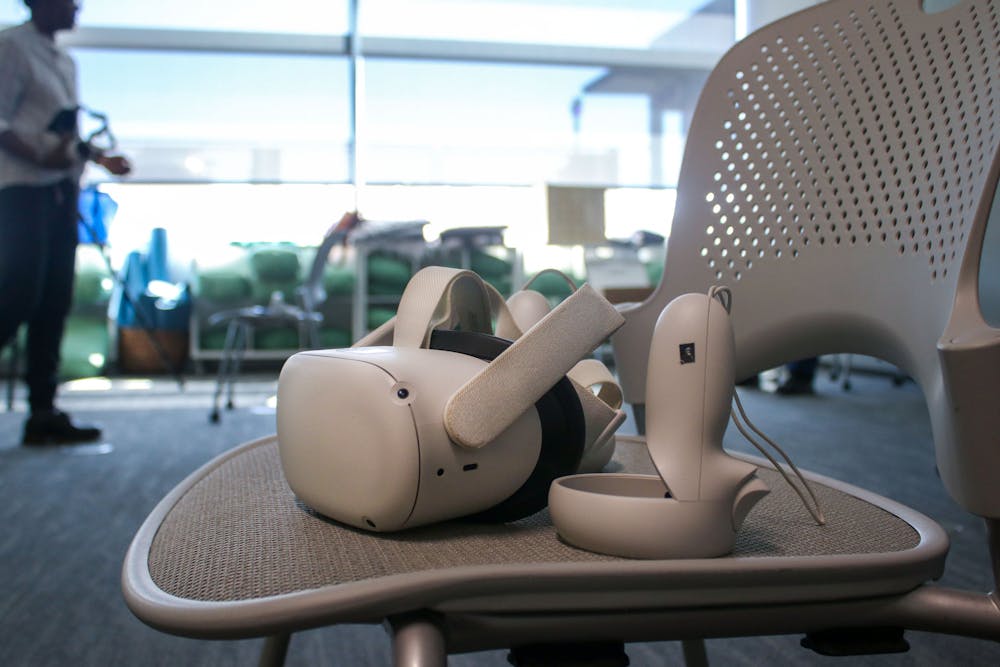A player sits in a chair — their head swiveling behind a headset. Behind their goggles, a red button appears and a voice instructs them to press it. The user's breathing slows as they enter the virtual reality world, melting their outside stress away.
Through its drop-in sessions, the Center for Health and Well-Being is using virtual reality as a tool for students and faculty to reduce stress.
Puzzles, meditation and simulations are all activities that one can take part in through virtual reality. According to Robert Dawson, a clinical associate professor of neuropsychiatry and behavior science at the school of medicine, users experience signs of relaxation such as slowed pulse rates and increased respiration while participating in these aspects of virtual reality.
Farren Stackhouse, a clinical professor of neuropsychiatry who works with the Center for Health and Well-Being to put on the virtual reality sessions, researches the effect that virtual reality has on users’ mental states and its possibilities regarding therapeutic treatment.
“VR can be used for gaming, but it doesn’t always have to be used for that," Stackhouse said. "You can use it intentionally and try to get past some traumas (or) try to get past some anxiety. You can use it to enhance muscle memory for students that are dealing with illness or physical injuries.”
April Scott, the associate director of mental health initiatives for Student Health Services, said she decided to bring virtual reality to the C.A.L.M. Oasis — a room in the Center for Health and Well-Being that provides various stress-releasing events — after experiencing the anxiety-reducing effects first-hand at a conference last summer.
“It was one of the most relaxing things, and it maybe was five minutes, but I could feel my mood immediately just calm down,” Scott said.
After this experience, Scott connected with researchers at USC's School of Medicine that were already using virtual reality for research in order to provide a new approach to mental health mindfulness on campus.
“A lot of people, when they think of mindfulness and meditation, they think of just sitting still with their eyes closed for 20 minutes, and that’s not always the case," Scott said. "With the VR piece, I think this connects with people who may need a little more activity, but it still can be a form of stress management.”
Once users arrive, Stackhouse said they first assess their goals, which includes asking what brings the person into the session as well as any prior experience with virtual reality. After getting a new participant set up in the headset, the user begins with “First Steps” — a virtual reality introductory program where they are to explore the technology, relax and practice mindfulness.
"It teaches you how to connect with your body and not get caught up in your thoughts," Scott said.
Outside of her partnership with student health and the mindfulness practices, Stackhouse works with virtual reality through USC’s School of Medicine, researching in the school’s virtual reality labs as well as with the South Carolina Child Care Inclusion Collaborative technology center.
Through this research with other neuropsychiatrists like Dawson, mental growth and increased neural function can be seen while participants use virtual reality.
“We can actually show on a basic MRI that you can see the brainwave pattern very differently. This is where we talk about things like neuroplasticity," Dawson said. "Helping persons to basically develop new senses, new ways of working their brain, new ways of retraining cognitive function."

As research from individuals like Dawson and Stackhouse grows, Scott said she plans to continue channeling virtual reality technology into supporting mental health initiatives at USC through more mindfulness sessions and additional partnerships with other organizations.
“It’s an innovative way of reaching people who may be uncomfortable in other settings," Scott said. "One question I always like to ask with some of our programs is, ‘Who’s not coming in, and how do we reach those students?'”
The Virtual Reality Mindfulness sessions take place on Tuesdays and Wednesdays from noon to 1:30 p.m. and are located in the Center of Health and Well-Being's C.A.L.M. Oasis space.

